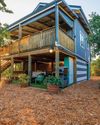
Great, grey beasts lumber on the horizon, their bulging forms stretching the sun-baked leathery skin that holds them. Their carbuncled trunks rise heavenward, sniffing the sky for rain, hoping to be relieved from the dry African heat.
This is the northern Kruger National Park in South Africa – a place where tuskers reign supreme. While many travel northwards to see these giant beasts, I have travelled here to see a grey beauty of a different kind. For me, it’s not the shapes of elephants that are the real icons of this landscape. This is the place where baobabs roam...
While the Kruger National Park’s massive footprint dwarfs some countries, its northern regions, and the lands that border the park up here, are still remote and relatively tourist-free. Venture here and you'll struggle to find an open safari vehicle jam-packed with khaki-clad tourists wielding oversized cameras. It’s a vast, often barren landscape, particularly in the winter months, that stretches up from the popular Letaba, Olifants and Mopani rest camps, until you reach Shingwedzi and travel ever northwards to Punda Maria. Visit in the dusty dry months, like I did, and you'll thank yourself for planning for mosquito-free cooler weather, but you’ll want to stick along the riverbeds, where sightings are more frequent. And while we were lucky enough to see mating lions, a leopard in a tree, one naughty honey badger, and a pack of playful hyena pups in this central section, it was from Punda Maria rest camp onwards that the magic really happened.
Way up north
This story is from the March 2020 edition of Skyways.
Start your 7-day Magzter GOLD free trial to access thousands of curated premium stories, and 9,000+ magazines and newspapers.
Already a subscriber ? Sign In
This story is from the March 2020 edition of Skyways.
Start your 7-day Magzter GOLD free trial to access thousands of curated premium stories, and 9,000+ magazines and newspapers.
Already a subscriber? Sign In

Fit For Purpose
Changing legislation offers a range of opportunities in the health sector

Good For Grinches
Finally! A holiday season Scrooge himself can invest in

A Paradise In The Wilderness
Visitors find freedom at Treedom on the Garden Route

Do It For The Kids
Parenting styles play an important role in helping children develop through the pandemic and beyond

Trekking With Teens
Travelling with adolescents comes with a unique set of challenges

Know Your Mind
Our brain uses shortcuts to think quickly but, sometimes, these mental timesavers let us down. Dr Pragya Agarwal discusses the science of cognitive biases, and why it’s more important than ever to understand how they hold sway over our views

Infected With The Travel Bug Again
As tourism-related establishments up their game to ensure visitor health and safety, it’s possible to feel positive about travelling again

Star attraction
Greater Kruger lodge makes a spectacular first impression

Palala position
The effect of the past on the present is positively felt in a luxury Waterberg lodge

Can the spam!
Irrelevant advertising will almost certainly turn consumers against your product